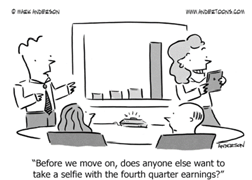
April 2018

Change Or Die
By Alan Deutschman
If you were given the choice to change or die – to make meaningful and enduring shifts in the way you think, feel and act, or pass away much sooner than you were meant to – would you be able to survive? According to Fast Company senior writer Alan Deutschman, the answer is probably no.
But in his book, Change Or Die, Deutschman outlines how exactly to go about transforming our outlook and the way we interact with the world on a fundamental level.

Don’t Ever Let Your IT Company Do This To Your Computer Network
Today, when companies need to be lean, nimble and brutally efficient to survive in a competitive marketplace, cutting unnecessary costs is paramount. Unfortunately, it can be easy when you’re on a tight budget to accidentally strip away components of your business that may seem gratuitous but are actually essential to your success.
One of the first things that often ends up on the chopping block in the frenzy to save money is IT. Instead of continually investing in managed IT services, where professionals carefully maintain, protect and update your network month to month, some businesses decide that the best way to keep their technology running smoothly is to simply leave it alone, calling up a professional only when something breaks down.
Of course, this approach forgoes monthly costs and shaves off a fair few dollars from your technology budget in the short term. But while this approach may seem cost-effective, it opens up your business to a huge variety of technological crises, from expensive network outages to cyberattacks that may cripple the very future of your company.
The Problem With A ‘Break-Fix’ Strategy
It can be hard to imagine the huge list of problems that might arise within your network. So, it’s an understandable strategy to wait to do something until an issue becomes a serious problem. At that point, they bring in a professional who – charging by the hour – attempts to find and repair whatever may be broken.

It seems like a logical approach, but unfortunately, it’s littered with huge hidden costs. If you’re calling an IT expert only when something in your network is broken, only your most urgent technological needs are addressed. When your technician is being paid an hourly wage to fix a specific issue, there’s no incentive to be proactive with your system. They won’t recommend important, money-saving upgrades or updates, and they will rarely be able to detect a crisis before it happens.
“Instead of continually investing in managed IT services...business owners decide that the best way to keep their technology running smoothly is to simply leave it alone, calling up a professional only when something breaks down.”
What’s more, the “if it ain’t broke, don’t fix it” approach very likely leaves huge holes in your security and drastically magnifies the costs of an IT meltdown. If they’re only arriving in the midst of crisis, there’s hardly ever an opportunity for the breakfix technician to strengthen the barriers between you and the hordes of hackers clamoring for your data. They’re on the clock, being closely monitored to fix the problem and then go away. Meanwhile, the security landscape is constantly changing, with criminals and security experts in a back-and-forth arms race to stay abreast of the latest developments. Without someone managing your system on a regular basis, your protective measures are sure to become woefully out of date and essentially useless against attack.
Why Managed IT Services Are The Answer
When you turn over your IT needs to a managed services provider (MSP), you’re entrusting the care of your network to a team of experts who have a real interest in your success. MSP engineers regularly monitor the health of your system, proactively preventing disaster before it enters into the equation and hurts your bottom line.
Beyond this preventative care, MSPs do everything they possibly can to maximize the power and efficiency of your equipment, implementing only the best practices and the latest software and updates.
When you invest in an MSP, you may have to invest more funds initially, but likely you’ll save tens of thousands of dollars in the long run by avoiding cyber-attacks, downtime and hourly rates wasted on a technician who doesn’t really care about the future of your business. When you choose an MSP, you’re not just choosing a superior and healthier network – you’re choosing peace of mind.
Free Report: The Top 10 Ways Hackers Get Around Your Firewall And Anti-Virus To Rob You Blind

Cybercrime is at an all-time high, and hackers are setting their sights on small and medium businesses who are͞ low hanging fruit.͟ Don’t be their next victim! This report reveals the most common ways that hackers get in and how to protect yourself today.
Provided as an educational service by:
Mark Bowles, President
Ranger Business Solutions
5310 Harvest Hill Rd. Suite 125
Dallas, TX 75230
Tel: (214) 329-1349, Fax: (214) 853-5715
www.rangersolutions.com
19 Ways To Live Well And Sanely In Crazy Times
There’s no discounting the fact that we’re living through some crazy times. With political upheavals, game-changing social media movements and chaotic world events, there’s a lot going on.
1. Don’t add to the craziness. Be civil to those with whom you disagree. Balance your heart and your head so emotions don’t outweigh reason.
2. Separate fact from opinion. Don’t get excited about things that either aren’t true or are wildly exaggerated to get attention. Daniel Patrick Moynihan said, “Everyone is entitled to their own opinion, but not to their own facts.”
3. Act with integrity even when others don’t. Just because others are behaving badly doesn’t mean you should too.
4. Slow down. The longer I live, the more convinced I am that you accomplish more of real importance by slowing down. Speed is necessary at times, but make sure you’re not chasing rabbits when you could be tracking the big game.
5. Eat slower. A friend’s father-in-law was a doctor, and when asked what was the most important thing a person could do to improve their health, he said “Chew more.”
6. Get enough sleep. Lack of sufficient sleep is a major influence on poor health, both mentally and physically.
7. Read for education and entertainment. The best novels aren’t just engaging, they teach us something about the world and about ourselves. In addition, read about current events and personal development to keep well-rounded.
8. Limit your news intake. Being saturated with more of the same, day in and day out, can be fatiguing and frustrating. Be informed, but not inundated.
9. Exercise. It’s as simple as that.
10. Have deeper conversations with friends. Go beyond, “How’s it going?” to “What are you thinking?” Move past the superficial and really connect.
11. Take a trip. The best way to enlarge your perspective is to travel abroad. But if you can’t, for whatever reason, visit a new state or spend time in a museum.
12. Be civil.
13. Be kind.
14. Count your blessings every day. To be precise, list at least three. No matter how bad it gets, there are always things to be thankful for.
15. Spend less than you make.
16. Invest more in experiences and less in stuff.
17. Live intentionally. Be specific about what you want to accomplish each day. Don’t sleepwalk through your life.
18. If you can’t take action to deal with something, don’t worry about it. And if you can, then do it and stop worrying!
19. Tell people you love that you love them. You’ll rarely regret telling someone that you love them, especially when you no longer have the chance to do so.

Mark Sanborn, CSP, CPAE, is the president of Sanborn & Associates, Inc., an “idea studio” that seeks to motivate and develop leaders in and outside of business. He’s the bestselling author of books like Fred Factor and The Potential Principle and a noted expert on leadership, team building, customer service and company change. He holds the Certified Speaking Professional designation from the National Speakers Association and is a member of the Speaker Hall of Fame. Check out any of his excellent books, his video series, “Team Building: How to Motivate and Manage People,” or his website, marksanborn.com, to learn more.
Shiny New Gadget Of The Month:

4K HDR Projector Can Beam A 150-Inch Picture Onto Your Wall
A 65-inch OLED TV is a beautiful thing. But can it compare to a crisp, bright 150-inch display in the comfort of your home?
That’s what LG is offering this year with its new 4K HDR projector, the HU80KA. Clocking in with a 3840 x 2160 resolution, 2,500 lumens and a stunning picture, the portable device is an attractive offer indeed.
The device is only a few feet tall, but it looks like it will be the ideal piece of equipment for home theater enthusiasts. It’s the closest you can get to the big-screen experience, and you won’t even have to plonk down 20 bucks for a tub of popcorn. It remains to be seen, though, whether it’ll be worth the price tag. At the time of writing, the price has not yet been released, but bulkier, less portable competitors cost a little under $2,000.
Why Inclusion Matters In The Workplace

For companies that want to survive in the modern marketplace, diversity is more than a buzzword – it’s a fundamental ethos that is key to real success. In order for innovation to happen, dozens of perspectives and worldviews need to be represented in your workplace. But what does that inclusion actually look like? One thing is for sure: It must go beyond written policies and initiatives. Instead of giving lip service to an abstract concept, inclusiveness must exist in the daily actions and behaviors of your entire organization.
Here’s The One Reason Why You Need So Many Different Passwords...

Thinking up passwords and managing them is a big pain, no two ways around it. One website requires a symbol, and another requires 14 characters. Meanwhile, your bank requires 10 characters, four PIN numbers and the answer to a secret question. In the midst of all this, it’s easy to just use the same three or four passwords for everything – after all, that’s more secure than a single password, right?
But imagine this. Say you use the same password for your Gmail, your Amazon and the account you use to order gift cards at a 10% discount for client gifts. One day, the gift card website is hacked. Not only do the crooks get your credit card info, they also get the list of all the website’s users and those users’ passwords. Then, they publish these freely on the Internet.
But if you use different passwords for all your accounts, you’re safe despite any crisis that may arise. Make sure you practice good password security.
4 Ways To Improve Customer Satisfaction And Increase Your Profitability At The Same Time
1 Host an event. In B2B companies and small businesses that have a highly specific and local customer base, a big appreciation event can go a long way. Just make sure to view attendees as friends rather than customers you’re trying to close on.
2 Personalize your services. If you’re able to tailor your offerings to your customers’ desires, that extra effort can really impress the people you serve. It doesn’t have to be complicated. Get creative and add that little bit of human touch to your product.
3 Send handwritten notes. E-mails, social media and phone calls are great, but if you want a thank-you card or customer appreciation note to stand out, it’s best to write them by hand.
4 Launch a loyalty program. These programs can increase profits for you and your business, but they’ll also have the benefit of making your most loyal customers feel engaged and appreciated. SmallBizTrends.com Jan. 16, 2018.
Cartoon Of The Month




